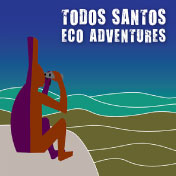by Bryan Jáuregui | Adventure, Culture, Travel Industry
This article by Bryan Jáuregui of Todos Santos Eco Adventures and Mario Becerril of Mario Surf School was published in the Summer 2012 issue of Janice Kinne’s Journal del Pacifico.
In the age of jet-setting surfers pursuing monster waves across the globe for fame and money; of California surf breaks so crowded it is not uncommon to see 100 boards or more in the water; of jet skis towing surfers to catch waves that the human body could never conquer on its own, it is wonderful to hear Todos Santos resident Steve Merrill recall the age in which he first saw a surfer. “It was 1956 and I was six years old. My parents were driving the car along Pleasure Point in Santa Cruz, California, and I saw a guy standing on a giant wooden board gliding across the waves, completely alone on the water. It is impossible to describe the impact that vision had on me. I knew then and there that surfing was what I had to do.” Steve’s immediate enthrallment with surfing is echoed in the voice of the young narrator in Australian writer Tim Winton’s surfer-coming-of-age novel Breath, “How strange it was to see men do something beautiful. Something pointless and elegant, as though nobody saw or cared…as if dancing on water was the best and bravest thing a man could do.” Back in the day, Winton tells us, surfing was the closest a man could get to poetry.
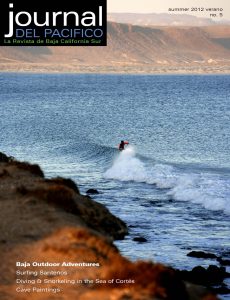
If surfing is akin to poetry then Todos Santos today is the City Lights Bookstore and the Beatniks are having a poetry slam. “We’re living the bonus years here in Todos Santos” says surfing resident Billy Girvan. Like many expats in the Todos Santos surfing community, Billy grew up in California just as surfing culture was taking root. “In 1959 I was 12 years old and saw these guys surfing in Santa Barbara. All I wanted was to be like them. It wasn’t just the surfing, it was the life style that was so appealing, the beach life, the freedom. They were so different from everyone else. I traded my go-cart for a surfboard and never looked back.” Todos Santos surfer Jim McRoberts knows just how he feels. “In 1962 I was 15 and living in Sierra Madre, California. My uncle was a founding member of the San Onofre Surf Club and took me with him to the beach one day. That first time riding a wave, the sensation was simply amazing. It took hold of me immediately and I couldn’t think of doing anything else. My passion has never lessened from that day to this.” Like Billy, Jim was just as in love with the surfing culture as with the surfing itself. “Everything important was happening at the beach.”
Billy, Jim, Steve and countless other expat surfers living in Todos Santos went from being “grommets”, or “gremmies” – slang for young surfers – to embracing the full surfing life as older teens and adults. A lot of school was missed, a lot of pretty girls chased, a lot non-food items ingested and a whole lot of waves caught. Poetry? Absolutely. “Poetry is not only dream and vision” says poet Audre Lorde, “It is the skeleton architecture of our lives. It [is] a bridge across our fears of what has never been before.” For these boys surfing was the bridge to embracing nature in a most intimate, thrilling and terrifying way. Surfing was the bridge out of an ordinary life into something sublime. Surfing was the bridge to salvation. “Going to the ocean is like going to church for me.” says Jim who went on to get a Masters in English and is currently writing a novel about surfing. “If it wasn’t for surfing I would have been a drug addict or alcoholic like a lot of my friends. You have to stay physically fit to surf. It saved me.” Billy, who went on to become a founding member and bass player for the hard rock band NoXit, agrees. “I was in the midst of living this rock star’s life and surfing is definitely what kept me healthy, what kept me alive.”
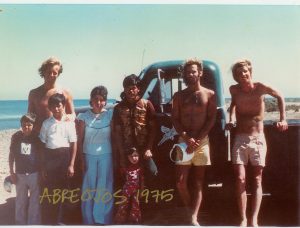
Steve Meisinger and Friends in Baja in 1975
As countless movies and songs throughout the 1960’s and ‘70s glamorized surfing culture, the surf breaks in California inevitably became more crowded and surfers became more territorial and protective of their breaks, often resulting in a tense and aggressive atmosphere. Some surfers, like Steve Meisenger, or “Meisy”, started looking elsewhere and in 1973 at the age of 18 the Morro Bay, California board shaper started coming to Baja to enjoy the peninsula’s stark beauty and uncrowded breaks. “I was getting a degree in Ornamental Horticulture at Cal Poly and would save all the money I made shaping boards during the year to come to Baja in the summer. We would live in the van and camp on the beach. We never went out to eat, we never stayed in a hotel. All of our money went to surfing and survival.” Meisy started a successful, 30-year career as a housing contractor but continued to come to Baja at least once a year. He stumbled upon Todos Santos in 1981 while looking for a mechanic. He was captivated. He found himself returning to surf the breaks here every year, and by 1990 had bought property and started building his house. “The environment in most of Baja is so harsh, but in Todos Santos we get the great waves as well as this lush environment, great weather and wonderful creature comforts.”
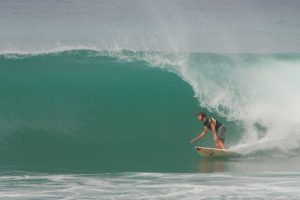
Steve Merrill Surfing in Todos Santos. Photo by Sam Belling.
The magic of Todos Santos surfing has a powerful pull. By the time Billy first visited Todos Santos in 1994 it had been 14 years since he’d last been on a surf board. But much to his joy he found that he could still ride the waves. Much to the consternation of his wife he also found that he really wanted to surf all the time, once again. “But luckily that beautiful woman really loves me so when I said I wanted to move to Todos Santos to surf she backed me 100%. We sold all of our property and here we are.” Jim knows just what he means. When he and his wife married in 1989 they moved to the mountains of Oregon so they could pursue her love of horses. “But I thought about surfing every single day, and even carved a sculpture of a wave to put over the mantel.” A 3-year road trip throughout the North American continent brought them to Todos Santos in 2009. It had been 20 years since Jim was last on a surf board, but the magic returned immediately. “Every good wave that you ride is like a gift. It is this energy that is there for you personally, energy that has come 2,000 miles for you to merge with and take to the Todos Santos shore.” Jim and his wife sold their Oregon property and have been in Todos Santos ever since.
No matter whether they surfed every day for the past 5 decades or abandoned the waves for years, surfing still provides the “skeleton architecture” of these men’s lives as they move through their 60s. And one of the key reasons they love surfing Todos Santos is, as Steve says, “This is as nice a surfing community as anyone could ever hope to find. There is hardly any localism and everyone on the waves is respectful and supportive of each other in the water.” While they may not have the stamina and moves of youth, the men don’t seem to mind (much). “Let’s face it” says Billy, “the best surfer out there is the one having the most fun. And that’s usually me!” Coming from a guy with 2 titanium bars, 4 screws and 3 vertical spacers holding his back together, that’s no mean feat. Billy already has days on the water when his back prevents him from getting up on the board, and he can see a time coming when he won’t be physically able to surf any more. “But I’m just not that worried” says Billy. “There is always mind surfing!” Poetry? Oh yes indeed.
by Bryan Jáuregui | Culture
by Todos Santos Eco Adventures
In the 1980s the Dalai Lama identified a Spanish kid as the reincarnation of a Tibetan lama who had died a few years before in California. The boy was placed in a monastery in India with other children believed to be reincarnations and trained to the spiritual life. He thought it sucked. Once he turned 18 he hit the road, lived next door to Richard Gere for a while, then became a film student in Madrid. He made it very clear in press conferences that he’d rather be slathered in honey and tied to an ant pile than assume the spiritual leader mantle.
So the next time the Dalai Lama thought he found a reincarnation of a spiritual leader in a Spanish-speaking country like, say, Mexico, it’s not difficult to conjecture that he took pity on the kid – compassion being pretty much rule number one in the Dalai Lama handbook – and just let him grow up with his family and make his own way to his destiny. What would that life look like? What would that destiny look like? Well, to start, it is said that lamas do have some say in who they will be reincarnated as so it’s likely that that the Mexican kid would have been born to vegetarians, the type who practice yoga and meditation, the kind of people who would have helped him understand the strong connection between mind and body by giving him a massage every Sunday night before the start of the school week.
So of course he would be very strong in mind and body, probably winning Athlete of the Year during all four years of high school and being captain of the Mexican team in the 13th annual International Young Physicists Tournament in Budapest. For example.
In college, given the volatile state of the environment, the resulting stress on our oceans and the implications for all the life that depends on it, he naturally would be drawn to marine biology. And, having decided on marine biology, he would of course go to the best school in the land for such studies, UABCS in La Paz. Likely a proponent of Think Globally, Act Locally, his BS thesis would be something like Environmental Diagnoses for the East Cape Coastal Zone, Los Cabos, Mexico.
Now that family he chose to reincarnate into would of course be helping with his spiritual education, but in the subtle, roundabout way that some effective families have. For example, a beloved uncle might give him a book about someone he found inspiring, someone who dedicated his life to helping mankind. Someone like Sri Aurobindo, the founder of Auroville, India, a place recognized by UNESCO since 1968 as a project for the good of mankind, where people from all over the world go to engage in an ongoing “experiment in human unity, transformation of consciousness, focus on sustainable living and the future cultural, environmental, social and spiritual needs of mankind.” This book would really speak to him and he would finally (and the Dalai Lama might say inevitably) go to India. Unlike the Spanish kid who was forced to go, the Mexican kid would think India was da bomb.
The Mexican kid would probably go on that first trip to India just as a tourist, but it would confirm and further define his path in life. Upon returning home he might try a Vipassana, or Insight Meditation retreat, and learn the power of meditation to bring together mind, body and spirit. This might then prompt him to organize a series of conferences entitled something like “Que es la Vida” or “What is Life?”, using science to explore new ways of defining life. Always questing for knowledge, he’d likely continue his studies by pursuing a Masters of Science in Marine and Coastal Sciences, with a thesis on something like Management Program of the Corridor Los Frailes-La Ribera, Municipio de Los Cabos, Baja California Sur, México; Using a Model of Environmental Indicators. And when he got his Masters he’d continue to Think Globally, Act Locally, working with organizations like the World Wildlife Federation to organize and implement a series of local workshops around a worldwide event like “Earth Hour”, in which populations across 135 countries switch off essential lights for one hour in celebration of the world’s largest voluntary environmental action, while also developing a management plan for the fishing community in Magdalena Bay.
And, without a doubt, he would find his way to a pueblo magico, to a place called All Saints, where he would continue his integration of mind, body and spirit by learning to surf. And doing more yoga. And more meditation. And embarking on a career in massage. In fact, even when his Master’s thesis gets (some would say inevitably) published as a book by Editorial Académica Española in Spain, he’d likely decide to take his budding practice to the next level of therapeutic massage, helping others to experience the healing benefits of mind, body and spirit integration. Naturally he will do his training in Auroville, India. The Dalai Lama couldn’t have planned it better!
And that Mexican kid – now a young man – could be one of your neighbors. He could be one of those surfer dudes that you see at Los Cerritos, or one of the massage therapists that you see working with guests at Los Colibris Casitas while on a Todos Santos Eco Adventures trip, or maybe even one of the baristas at Baja Beans. In fact, he could be all of those people. And of course he doesn’t have to be the actual reincarnation of a lama to set a great example of a life lived in joy and focused on helping others. Even the Dalai Lama said that we can live without religion and meditation but we can’t live without friends. Hesed does mean “friend” in Hebrew. And sometimes – although we will miss them – we have to rejoice in our friends going far away to places like India to pursue their destinies and fulfill their dreams. We just hope that the lure of our magic village brings them back to us.
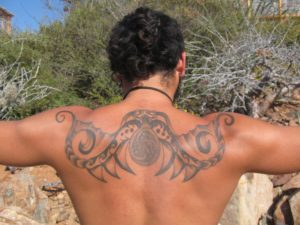
What’s in a tattoo?
Hesed’s back tattoo is actually two tattoos working together as one. The first one is the circle in the middle which he got in Indonesia. “It’s a mandala of who I am, radiating light out from a circle in the middle.” The three spirals within the circle stand for the elements of earth, water and fire. The second one is, most obviously, a snake, which in prehispanic culture represents Mother Earth. Hesed has two other tattoos on his chest and is working on the design for a new one to go down his left arm.
© Copyright Sergio and Bryan Jauregui, Casa Payaso S de RL de CV, 2012
by Bryan Jáuregui | Adventure, Travel Industry, Wildlife
This article by Todos Santos Eco Adventures was published in the Spring 2012 issue of Janice Kinne’s Journal del Pacifico.
If you sift back through the catalog of parental admonitions that were meant to ensure you a long and happy life – you know, “don’t stick your tongue on frozen metal”, “don’t eat yellow snow”, “don’t drink your father’s last bottle of beer” – somewhere buried in there your mother must surely have added “and oh yes dear, don’t swim with sharks”.
Very sound advice to be sure but swimming with sharks – whale sharks that is – in the Sea of Cortez is truly one of life’s great (and, sadly for you danger junkies, very safe) adventures. While whale sharks have thousands of teeth in hundreds of rows in their enormous mouths (imagine armed shark mouths 4 to 5 feet wide), they can neither bite nor chew. That’s right, they are happy to forego all human body parts in favor of plankton, krill and small fish. Go figure!
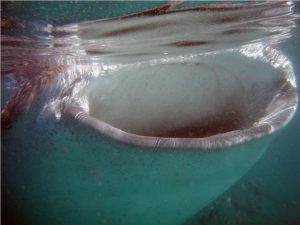
Whale Shark Mouth! Photo by Deni Ramirez
So now you feel safe but even if you were on the varsity swim team you’re probably wondering how you could actually keep pace with a shark in the water. Well, the whale shark got its moniker because it is the only fish that is literally as big as a whale; mature adults can reach 60 feet in length and 50 tons in weight. Reaching these proportions requires an immense amount of energy, which the whale shark gets by consuming huge volumes of plankton-rich water, then straining it out through its gills. In fact, to get the food it needs it is not unusual for a whale shark to filter 400,000 gallons of water an hour. To conserve this hard-won strength – and continue eating – whale sharks tend to do a lot of hanging about in the water, or, if moving, doing so at a very slow pace. This lollygagging is what makes it possible for non-bait types like humans to jump in and swim alongside them for a bit. Of course, when they want to put on the speed they certainly can so when a whale shark tires of your company all you will see is a swishing tail receding into the distance.
Now you’d think it’d be a relatively simple matter to learn about a mammoth fish the size of a school bus dawdling through the water eating up everything in its path. But the fact is that scientists still know relatively little about the whale shark, and La Paz resident Dení Ramirez of Whale Shark Mexico is trying to change all that. Originally from Mexico City, Dení has been studying whale sharks in La Paz since 2001, and completed her Ph.D. in marine biology last year. The whale shark’s skin is covered in a pattern of pale yellow spots and stripes that is unique to each animal, a type of fingerprint if you will, so Dení has been able to track some of the inhabitants of La Paz Bay. In fact, she has been tracking the young sharks Flavio, Tikki Tikki and Tango for almost a decade now, and has determined that they are true Baja residents. While whale sharks have been spotted across the globe from Australia to Djibouti, from the Philippines to Mozambique, Dení’s juveniles appear to travel only in the Sea of Cortez, from the Bay of La Paz to Bahia de Los Angeles – roughly 600 miles. We asked Dení why we seem to be seeing the whale sharks around La Paz so much more over the last couple of years than we ever did before.

Whale Shark Feeding in the Sea of Cortez: Photo by Deni Ramirez
“It’s really just a question of food. Over the last two to three years the conditions in the Bay of La Paz have been just right to produce an enormous amount of plankton for the whale sharks to feed on. The wind, currents, mangrove conditions – all these have combined to create an excellent environment for plankton growth that we just didn’t have for such extended periods in earlier years. Also, in the Bay of La Paz the plankton is rich in the coastal waters, and these relatively shallow waters give the young sharks in my group a certain amount of protection.” Dení is happy to take visitors with her on her research trips and share some of her extensive knowledge of whale sharks and research methodology.
Dení is currently doing a lot of work with the pregnant females who inhabit the deeper waters around Espiritu Santo Island and have found that they have much larger migrations than the young sharks due to their different needs as mothers, mothers who surely will work to ensure the long life and happiness of their offspring by admonishing “and dear, don’t try to eat the humans. They’ll just clog up your gills.”
TOSEA guest Mary Winzig recounts her whale shark adventure:
“Swimming with whales sharks is the most amazing thing I have ever done in my life. They are such magnificent animals and I felt so lucky to be in their presence. I was scared—to see something so large and to know you are jumping in the water with them made me pause for a moment. My heart seemed to be almost leaping through my wetsuit – I asked the guide to make sure they were whale sharks because their dorsal fins were so huge! But after watching them and seeing their polka dots, I realized I had to swim with them. You can’t be afraid of anything with polka dots! Jumping in and seeing them through the snorkel was magical. Once I was in the water, I wasn’t afraid. I have no idea how long I was in the water with them, 2 minutes? 15 minutes? I was transfixed. Their mouths look like the grill of a ‘57 Chevy. I have never felt so small or insignificant, but also so powerful. I have decided I have to do everything in my power to help save these magnificent creatures. Thank you Todos Santos Eco Adventures for this wonderful opportunity. I look forward to swimming with the sharks again!”
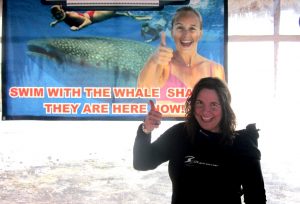
Mary Winzig After Swimming with Whale Sharks
© Copyright Sergio and Bryan Jauregui, Casa Payaso S de RL de CV, 2012
by Bryan Jáuregui | Culture
by Todos Santos Eco Adventures
So there she was in Boston on Patriot’s Day 1976 explaining to Rosalynn Carter that her (Rosalynn’s) luggage had been stolen out of her (Donna’s) car while they made a campaign stop on the way to the hotel from the airport. Rosalynn was sad because the bible that Jimmy had given her years before was in the luggage. Donna was sad because she thought this snafu pretty much spelled the end of life as she knew it. She was right. To help the luggage-less future first lady Donna ran around town and bought Rosalynn all of her favorite beauty products, and Rosalynn was very touched by this act of kindness. So touched that when she and Jimmy moved into the White House she invited Donna to a state dinner in honor of German Chancellor Helmut Schmidt. Now invitations to state dinners at the White House are traditionally bestowed only on the true elites of the business, political and entertainment worlds, not 26-year-old legal secretaries cum campaign volunteers. Donna was stunned by this remarkable expression of thanks for a kindness she had rendered, and she took to heart what it means to not only help people when you can, but to express gratitude for the kindnesses you have received. The children of Todos Santos are benefitting greatly from these lessons.
But long before arriving in Todos Santos (and not so long after leaving her secretarial job) Donna moved into a very elite world herself, co-owning and operating one of the finest restaurants ever to grace the city of Boston, L’Espalier. Often credited with being the first independently owned restaurant to bring haute cuisine to Boston, L’Espalier opened in 1978 and to this day remains the only independent restaurant in New England to receive Five Diamonds from AAA. When she sold her share of the business in 1988, Donna moved to Virginia and thought she would concentrate solely on being a mother for a while. She did. But not long after she’d enrolled her youngest child in kindergarten she decided to open another restaurant, which she also sold for a nice profit a few years later. But not before she married one of her best customers, a BMW dealer named Marc Viglione.
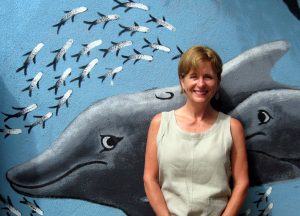
School’s in Session with Donna Viglione at The Palapa Society
Now Marc is a man who has always loved the water and not long after he and Donna married in 1995 they decided to move to an ocean-side town in New Jersey. When they bid at a silent auction for charity they naturally put their money on a week at a 16,000 square foot ocean-side vacation house in Cabo… and won! So in 2003 the whole family headed down to Baja. But the surfing in Cabo was not to the liking of Donna’s son Omar so he persuaded the family to take the drive up to Los Cerritos in Todos Santos, a drive that they wound up repeating every single day of the vacation. But Donna and Marc weren’t making the drive just to cater to Omar’s surfing passion; they had quickly developed their own love for Todos Santos, one of the loveliest ocean-side towns they had ever seen. By the time they got on the plane to go home they had bought a house in Todos Santos, albeit with a limited deposit of $300 as that was all the cash they could get out of the ATM machine.
When they got back to New Jersey the Vigliones closed their business, sold their home, sent the rest of the money for the house in Todos Santos, and returned to Baja for good just a few months after first stepping foot on the peninsula. Omar was thrilled and Donna thought she would concentrate solely on being a mother for a while. She did. But soon the house had been remodeled and her son’s days were filled with surfing and high school so in the summer of 2004 she enrolled in a conversational Spanish class. She thought it would be fun to teach her Spanish-speaking friends English, and by the fall of 2005 she’d started an after-school English-language program that met at the Cultural Center. At around the same time she started volunteering at the library of The Palapa Society – a Mexican non-profit focused on improving the lives of local children – and they soon invited her to be on the Board of Directors. Not long after Donna was invited to bring her after-school Bridge-to-English program into The Palapa Society and when they moved into their new space in 2007 the program really took off. The numbers tell the story.
For this current 2011-2012 school year 70 students ranging in age from 5 to 17 are registered for the program, and 16 of those receive Palapa Society scholarships. An additional 45 Todos Santos students receive scholarships from The Palapa Society to pay for their high school education, and 19 receive Palapa Society scholarships for universities in La Paz. It’s a remarkable achievement.
One of the keys to Donna’s success is the passion of the volunteers in Todos Santos who give so generously of their time and talents. These include Todos Santos “Saint” Mario Berceril, the entrepreneurial surfer who runs an 8-week swimming program for the Palapa kids each summer; Todos Santos “Saint” Erick Ochoa, who took over from Donna as president of The Palapa Society in fall 2009 and works with local artists such as Gloria Van Jansky to teach the kids arts and crafts each Wednesday; and hero volunteers like Serena Saltzman and Tim Doyle who have so steadfastly nurtured the program and the abilities of the kids over several years.
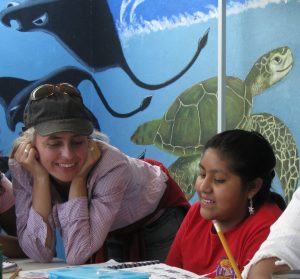
Volunteer Serena Saltzman with Palapa Society Student
The efforts of all these people and many more have made The Palapa Society’s programs so popular with the local families of Todos Santos that the society needs a larger facility to meet the demand. But where to find the money to purchase a permanent home? Well, as it turns out, two things we previously suspected are true: 1) rock ‘n roll really can save the world (or at least some parts of it), and 2) Rosalynn Carter is not the only one who knows how to make a grand gesture.
Peter Buck of the band REM bought a house in Todos Santos about 4 years ago and found he wanted to do something for the town, something specifically connected to education. He hooked up with the Hotel California and the Journal del Pacifico and about 60 days later – in January 2012 – the first annual Todos Santos Music Festival was in full swing. By the time the last guitar chord wafted from the stage $40,000 had been raised for The Palapa Society. But this was not just some one-off fundraiser. Peter Buck plans to make it an annual event to raise money for The Palapa Society and the next Todos Santos Music Festival is already scheduled for the 3 weekends of January 10-26, 2013. Plenty of time to get your tickets!
But if you can’t make it to the Todos Santos Music Festival or if music is just not your thing, there are other ways to get involved. You can:
• Visit The Palapa Society web site to donate, volunteer or both
• Participate in the Todos Santos Eco Adventures VolunTourism Adventure Week
Martin Buber once wrote, “All journeys have secret destinations of which the traveler is unaware.” Rosalynn Carter. Peter Buck. Donna Viglione. The Palapa Society has been the secret destination for these and so many other travelers. Perhaps it could be for you too.
© Copyright Sergio and Bryan Jauregui, Casa Payaso S de RL de CV, 2012



